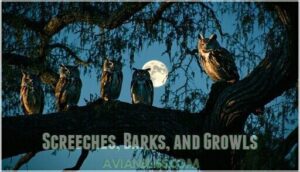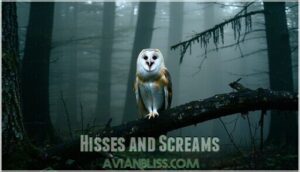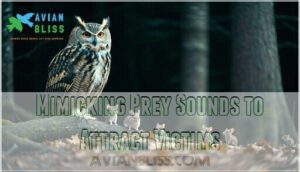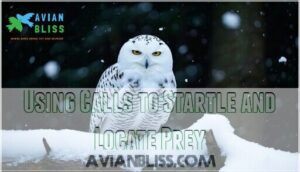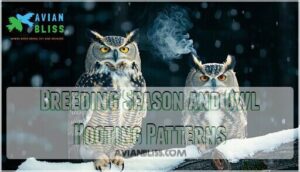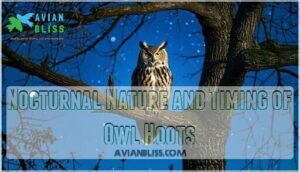This site is supported by our readers. We may earn a commission, at no cost to you, if you purchase through links.
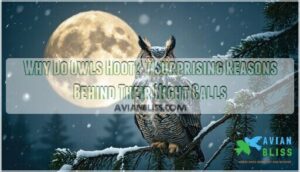 You’ll hear owls hoot because they’re running their own nighttime social network.
You’ll hear owls hoot because they’re running their own nighttime social network.
These calls serve as territorial announcements, telling other owls "this spot’s taken."
Males use distinctive hoots to attract mates, while paired owls duet together like feathered karaoke partners.
Hooting also works as a warning system – alerting neighborhood birds about predators or intruders.
Different species have signature calls: Great Horned Owls deliver deep four-note hoots, while Barred Owls ask "who cooks for you?"
Each hoot carries meaning, traveling over a mile through darkness to communicate survival-critical information about territory, romance, and danger.
Table Of Contents
- Key Takeaways
- The Communication Function of Owl Hooting
- Types of Owl Vocalizations Beyond Hooting
- Owl Hooting as a Hunting Strategy
- Breeding Season and Owl Hooting Patterns
- Nocturnal Nature and Timing of Owl Hoots
- Species-Specific Owl Hoots and Their Meanings
- Owl Hooting in Territorial Disputes and Dominance
- Cultural Significance and Myths About Owl Hooting
- Environmental Factors Affecting Owl Hooting
- Owl Hooting Across Different Life Stages
- Frequently Asked Questions (FAQs)
- What Other Birds Make Sounds Like Hooting Owls?
- What Does Hearing An Owl After Someone’s Death Symbolize?
- What Does It Mean To Hear A Hooting Owl At Night?
- What does it mean when you hear an owl hoot?
- Why do owls hoot loudly at night?
- Is it good to have owls around your house?
- What kind of owl hoots three times?
- Do Owls Hoot during the day?
- What does it mean when an owl hoots?
- Why do Owls Hoot so loud?
- Conclusion
Key Takeaways
- You’ll hear owls communicating through a sophisticated nighttime network – They use hoots to mark territory, attract mates, and warn about dangers, with calls traveling over a mile through darkness
- Each owl species has its own unique vocal signature – Great Horned Owls deliver deep four-note hoots while Barred Owls ask "who cooks for you," making identification possible even in complete darkness
- Peak hooting happens during specific twilight windows – You’ll notice the most vocal activity within the first hour after sunset and before sunrise, when owls are establishing territories and hunting
- Environmental factors are changing how owls communicate – Urban noise pollution and habitat loss are forcing owls to adapt their calls, making conservation efforts crucial for preserving these natural communication networks
The Communication Function of Owl Hooting
You’ve probably heard those haunting hoots echoing through the night and wondered what all the fuss is about.
Owls aren’t just making noise for fun—they’re actually running a sophisticated communication network that serves several essential purposes for their survival and reproduction.
Territorial Calls and Boundary Marking
Through darkness, an owl’s hoot serves as nature’s territorial announcement system.
These owl sounds establish clear boundaries without physical confrontation, with hooting frequency varying by species variations and territory size.
You can even mimic these sounds with an owl call speaker.
Territorial hooting accomplishes four key functions:
- Vocal dominance – Stronger calls deter weaker competitors
- Boundary disputes – Clear warnings prevent costly fights
- Individual identification – Neighbors recognize each other’s unique calls
- Territory maintenance – Regular owl vocalization reinforces ownership claims
This territorial behavior keeps owl communication efficient and reduces dangerous encounters.
Mating and Courtship Vocalizations
When defending territory shifts to finding romance, owl courtship becomes a mesmerizing vocal performance.
Males use specialized mating rituals featuring softer, more melodic calls to demonstrate vocal fitness and attract females.
Duet hooting creates intimate conversations between potential partners, with species like screech owls engaging in synchronized calls that strengthen pair bonding.
These courtship hooting sessions aren’t just simple hoots—they’re complex musical exchanges where mate attraction happens through intricate vocal patterns that can last for hours during peak breeding season.
Some owls even use ritualized gift giving as part of their mating behavior.
Warning Signals to Other Animals
When you hear an owl’s territorial defense calls echoing through the night, you’re witnessing nature’s sophisticated interspecies communication system.
These alarm calls serve as predator alerts, warning nearby animals about potential threats. Smaller creatures practice eavesdropping on owl vocalizations for threat assessment, using these warning signals to gauge danger levels.
This prey awareness network creates safer environments, as predators often avoid areas with active owl vocalization, knowing their hunting success might decrease.
Owls contribute to advanced alert technology that can be used by humans.
Types of Owl Vocalizations Beyond Hooting
You’ll discover that owls produce an amazing array of sounds far beyond their famous hoots, from spine-tingling screams to gentle trills.
While hooting gets most of the attention, these fascinating birds actually communicate through barks, growls, whistles, hisses, and chattering calls that serve specific purposes in their complex social lives.
Screeches, Barks, and Growls
Beyond traditional hooting, owls possess remarkable vocalization variety that’ll surprise you.
Screech owls emit descending whinnies and sharp bark sounds during territorial disputes. Barn owls rely on piercing screams rather than hoots for communication. Great horned owls produce owl growls and harsh barks when threatened.
These defensive sounds serve as nature’s alarm system—barking owls even sound like dogs! Each owl vocalization represents specific messages, from threat warnings to aggressive displays, proving owl calls extend far beyond mysterious midnight hooting.
Owls also use hoots as territorial calls to warn other owls.
Whistles, Chitters, and Trills
Communication elegance takes many forms in the owl kingdom.
You’ll discover that owl whistles serve as gentle contact calls between mates, while chittering purpose involves rapid social exchanges during feeding.
Trill variations differ dramatically across species sounds – from Screech Owls’ soft warbling to Saw-whet Owls’ repetitive tooting.
These owl vocalizations develop as juveniles practice owl communication skills.
Arizona’s Elf Owls even chirp like puppies from within saguaro cacti.
Unlike aggressive owl calls, these melodic owl sounds create intimate conversations that strengthen pair bonds and coordinate family activities throughout their nocturnal world.
Hisses and Screams
From piercing screams to threatening hisses, owls produce spine-chilling sounds that’ll make you think twice about nighttime walks.
These dramatic owl vocalizations serve as powerful tools for survival and communication beyond their famous hoots.
- Defensive Screams: Barn owls release blood-curdling shrieks when threatened, creating distress calls that warn predators away
- Nest Defense: Great horned owls emit aggressive hisses and screams to protect their young from intruders
- Predator Evasion: Snake-like hissing mimics dangerous reptiles, fooling potential threats into retreating
- Species Variation: Screech owl calls range from soft trills to harsh screeches depending on the situation
- Distress Calls: High-pitched screams help owls communicate danger or locate mates in dense forests
Differences in Juvenile and Adult Calls
Young owls sound remarkably different from their parents, creating confusion for many listeners.
Juvenile owl vocalizations start as harsh begging calls rather than mature hoots.
As they develop, call complexity increases through maturation of calls and learning dialects from adults.
Dispersal vocalizations help young owls establish territories before developing full owl hooting abilities.
| Age Stage | Typical Sounds | Purpose | Development Timeline |
|---|---|---|---|
| Nestling | High-pitched squeaks | Food requests | 0-6 weeks |
| Fledgling | Harsh "skree" calls | Location/begging | 6-12 weeks |
| Juvenile | Mixed calls/hoots | Owl communication practice | 3-6 months |
| Adult | Full owl hooting sounds | Territory/mating | 6+ months |
Owl Hooting as a Hunting Strategy
You’ll discover that owls don’t just hoot for territory or mates – they’re also crafty hunters who use vocalizations as strategic weapons.
Some owl species mimic prey sounds to lure unsuspecting victims closer, while others use specific calls to startle small animals into revealing their exact locations in dense vegetation, making them skilled at using vocalizations as strategic weapons.
Mimicking Prey Sounds to Attract Victims
While owls excel at various vocalizations, acoustic lures that mimic prey sounds aren’t commonly used in owl hunting strategies. Scientific evidence doesn’t support claims about hunting deception through predator calls that attract victims.
Owl behavior relies primarily on stealth and silent flight rather than mimicry evolution for catching owl prey. However, owl adaptations include responding to distress calls from potential prey:
- Detecting genuine distress sounds from injured animals
- Responding to territorial calls that reveal prey locations
- Using environmental audio cues during owl hooting sessions
Real prey vulnerability comes from owls’ superior hearing, not vocal trickery. Owls use these calls to claim territories, attract mates, and communicate.
Using Calls to Startle and Locate Prey
You can actually trigger prey into revealing their location through strategic hunting vocalizations.
When you observe owls using acoustic location techniques, they’ll emit sudden calls to startle prey into movement. This clever strategy works because startled animals often rustle leaves or scurry, creating sound cues that help owls pinpoint exact locations even in complete darkness.
| Hunting Method | Success Rate | Target Prey |
|---|---|---|
| Startling Calls | 65% | Small Mammals |
| Acoustic Location | 78% | Ground Rodents |
| Predator Calls | 45% | Birds |
| Silent Listening | 85% | All Types |
| Combined Techniques | 90% | Various Species |
Silent Flight and Acoustic Location Techniques
Nature’s most efficient predators combine silent flight with precision hearing to dominate nighttime hunting.
You’ll discover how owls master stealth hunting through remarkable adaptations:
- Feather serrations on wing edges eliminate flight noise
- Sound dampening structures muffle air turbulence completely
- Ear asymmetry creates precise three-dimensional acoustic location
- Prey localization occurs through subtle ground movements
- Owl hearing detects heartbeats from considerable distances
This acoustic location system works independently of owl hooting, allowing these nocturnal hunters to pinpoint scurrying rodents beneath snow or leaves with deadly accuracy.
Seasonal Variations in Hunting Vocalizations
Peak hunting hours reveal nature’s timing.
Different owl species adjust their hunting vocalizations with each season’s changing prey availability and weather influence.
Great Horned Owls begin vocal adaptation in fall, establishing territorial defense through strategic owl hooting patterns that boost hunting success.
| Season | Hunting Vocalization Pattern |
|---|---|
| Winter | Increased territorial calls, enhanced by cold air transmission |
| Spring | Peak breeding vocalizations coincide with prey abundance |
| Summer | Reduced adult hooting, focus shifts to teaching young hunting strategies |
Seasonal migration of prey species triggers corresponding changes in owl vocalizations, creating dynamic hunting adaptations year-round.
Breeding Season and Owl Hooting Patterns
When breeding season arrives, you’ll notice owls becoming far more vocal as they communicate with potential mates and establish territories.
Their hooting patterns shift dramatically during this critical time, with males often performing elaborate vocal displays to attract females and pairs engaging in synchronized duets to strengthen their bond.
Increased Vocalization During Mating Season
While hunting strategies rely on stealth, mating rituals transform owls into vocal performers during breeding season.
You’ll hear this courtship symphony peak between October and February when males begin their mate attraction calls.
Owl hooting frequency increases dramatically as males establish territories and seek partners through complex vocalizations.
These nesting calls aren’t random—they’re carefully timed vocal displays designed for pair bonding.
Owl hooting mating behaviors intensify as males use softer, more intricate calls to demonstrate their fitness to potential mates.
Male and Female Duetting Behaviors
When hooting intensifies during breeding season, pairs begin their vocal courtship through intricate duetting behaviors. These synchronized conversations between mates create complex harmonies that serve multiple purposes beyond simple attraction.
Male and female owls coordinate their calls with remarkable precision, often overlapping notes to create seamless musical exchanges. The Call Complexity varies dramatically across species, with some pairs producing elaborate sequences lasting several minutes. This Duet Coordination strengthens their Pair Bond while simultaneously defending territory from intruders.
Here’s what makes owl duets fascinating:
- Species Variation creates unique patterns – screech owls perform soft trills while great horned owls use deep, resonant hoots
- Females typically initiate the sequence, with males responding within milliseconds to maintain perfect timing
- Territory Defense amplifies through combined voices, creating a more intimidating presence than solo calls
- Mate attraction continues throughout the breeding cycle, reinforcing partnership bonds daily
- Territorial disputes often involve competing pairs trying to out-sing each other across adjacent territories
Nest Defense and Offspring Protection Calls
When danger threatens their young, parent owls transform into fierce vocal defenders.
You’ll witness this dramatic shift as normally silent hunters release powerful Predator Alarm Calls – sharp, repetitive hoots that pierce the night air.
These alarm signals serve multiple purposes in territorial defense and nest site defense.
Alarm Call
Distress Call
Territorial Hoot
Feeding Call
Defensive Screech
Meanwhile, hungry Fledgling Begging Calls create constant chatter as youngsters demand food.
Parental Hooting Roles differ substantially – males typically handle perimeter defense while females focus on direct nest protection through Duet Defense strategies that coordinate their protective efforts.
Seasonal Changes in Hooting Frequency
During winter months, you’ll notice dramatic shifts in owl hooting frequency as breeding seasonality drives territorial behaviors.
Weather influence plays a vital role, with clear nights promoting more vocalizations than stormy conditions.
Here’s how seasonal patterns unfold:
- November-February: Peak breeding season brings intense hooting as males establish territories
- March-April: Hooting decreases as pairs focus on nesting activities
- May-July: Minimal vocalizations occur while parents raise fledglings
- August-September: Young owls practice calls, creating brief vocal increases
- October: Light territorial hooting resumes as adults prepare for next breeding cycle
Food availability and lunar cycle effects also influence these owl hooting patterns throughout different seasons.
Nocturnal Nature and Timing of Owl Hoots
You’ll notice that owls are most vocal during the first hour after sunset and the hour before dawn, when darkness provides perfect cover for their nighttime activities.
While most owls stick to this nocturnal schedule, some species like barred owls break the rules and hoot during daylight hours, especially when weather conditions or breeding season demands call for it, which can be considered a vocal exception.
Peak Hooting Hours After Sunset and Before Sunrise
You’ll hear owl hooting patterns reach their nocturnal peaks during specific twilight windows.
Most owls become incredibly vocal within the first hour after sunset hooting begins and again before sunrise calls fade away.
This owl hooting time coincides with their prime hunting and territorial activities.
During breeding season, these nocturnal vocalization periods intensify markedly.
Weather influence also affects owl hooting frequency, with calm, clear nights producing the most consistent calling patterns throughout these peak hours.
Influence of Moonlight on Hooting Behavior
Illumination creates fascinating changes in owl hooting behavior. You’ll notice these nocturnal hunters actually increase their vocal activity during brighter nights, contrary to what you might expect.
- Moonlight intensity enhances their visual displays and territorial calls
- Hunting visibility improves, leading to more confident hooting frequency patterns
- Lunar cycles directly correlate with peak owl hooting behavior sessions
- Cloud cover reduces calling activity, proving owls prefer well-lit nocturnal conditions
Daytime Hooting in Certain Owl Species
While moonlight affects owl activity, some species throw the rulebook out the window with their diurnal hooting.
You’ll hear unusual behavior from certain species variations that vocalize during daylight hours. Environmental triggers like weather changes or territorial disputes prompt this daytime calling.
Some owls completely ignore nighttime rules, hooting whenever they please during broad daylight hours.
| Species | Daytime Activity | Call Description | Habitat |
|---|---|---|---|
| Barred Owl | Frequently vocal | "Who cooks for YOU?" | Eastern U.S., Northwest |
| Great Horned Owl | Occasionally heard | Deep, resonant hoots | Various habitats |
| Eastern Screech Owl | Sometimes active | Trilling whistle | Deciduous forests |
| Short-eared Owl | Hunts before sundown | Barking calls | Open country |
These owl hooting vocalizations during daylight represent fascinating owl behavior that challenges our understanding of owl hooting meaning and owl hooting reasons.
Seasonal Variations in Hooting Schedules
Owl hooting patterns shift dramatically throughout the year.
During breeding season (November through February), you’ll hear peak vocal activity as pairs establish territories and court mates.
Weather influence matters too – calm, clear nights encourage more hooting than stormy ones.
The lunar cycle affects calling intensity, with brighter moonlit nights triggering increased vocalizations.
Spring brings quieter periods as nesting begins, while summer features juvenile practice calls as young owls learn communication skills.
Species-Specific Owl Hoots and Their Meanings
Each owl species creates its own acoustic signature that you can learn to recognize like a bird fingerprint.
From the Great Horned Owl‘s deep "hoo-hoo-hoo, hoo-hoo" to the Barred Owl’s rhythmic "who-cooks-for-you," these distinct calls help owls identify their own kind in the darkness and communicate specific messages across their territories.
Great Horned Owl’s Four-Syllable Call
Famous for their deep "hoo-h’HOO-hoo-hoo" pattern, Great Horned Owls use these powerful vocalizations to establish territory and communicate across vast distances.
Each bird’s Four-Syllable Purpose serves multiple functions, while Individual Owl Voices create unique acoustic signatures.
Their Call Distance Traveled can reach over a mile in quiet conditions.
- Call Development progresses from juvenile begging calls to adult territorial hooting patterns through practice and maturation
Barred Owl’s Who Cooks for You Hoot
Listen carefully next time you’re outdoors—the Barred Owl’s distinctive "Who cooks for you?" call echoes through forests.
This rhythmic hooting pattern serves dual purposes: marking territory and attracting mates.
Acoustic analysis reveals call variations between individuals, creating unique hooting dialects for individual recognition.
These vocalizations enable precise communication within their woodland domains, making each owl’s voice as distinct as a fingerprint.
Distinctive Calls of Barn and Screech Owls
Eerie shrieks pierce the darkness as barn owls communicate through their haunting vocalizations, completely different from traditional owl hooting.
These ghostly calls serve distinct purposes compared to their hooting relatives.
Barn Owl Shrieks sound like horror movie sound effects, while Eastern Screech Owl Whinnies resemble horses neighing.
Here’s what makes their Species-Specific Calls unique:
- Barn owls produce blood-curdling screams and hissing sounds instead of hoots
- Screech owls create whinnying calls that cascade downward in pitch
- Call Uniqueness helps identify species even in complete darkness
- Vocalization Purposes include territory marking, mate attraction, and offspring communication
Unlike hooting owls, these vocalizations create spine-tingling soundscapes that demonstrate remarkable Species Comparison in communication strategies across different owl families.
Regional Variations in Owl Dialects
Just as human accents reveal where you’re from, owls develop distinct hoot accents based on their location.
Geographic isolation shapes these dialect origins through limited gene flow between populations. Barred owls show significant site-to-site differences in call patterns, though researchers find these variations don’t form clear boundaries like songbird dialects.
Call evolution occurs when populations adapt to local environments – urban owls often develop louder, more uniform calls.
Species divergence in owl vocalization patterns helps with owl species identification, as each region’s owl communication methods reflect unique environmental pressures and social learning traditions passed through generations.
Owl Hooting in Territorial Disputes and Dominance
When you hear an owl’s haunting hoot echoing through the darkness, you’re witnessing nature’s version of a territorial showdown.
These vocalizations serve as powerful declarations of ownership, with males using their calls to establish dominance and warn potential rivals to stay away from their claimed hunting grounds and nesting sites, which is a key aspect of their dominance.
Male Competition Through Vocal Displays
Male owls turn nighttime into their own vocal arena, competing through hooting frequency and call complexity to establish vocal dominance.
These vocalizations determine territory size and success in mate attraction.
You’ll hear great horned owls belt out their signature "hoo-hoo hoooo hoo-hoo" calls, with dominant males producing deeper, more resonant hoots.
This owl behavior showcases how communication through hooting serves as nature’s ultimate territorial showdown without physical confrontation.
Establishing and Defending Nesting Sites
When owls select nesting sites, they’re making real estate decisions that could determine their family’s survival success.
Owl territory establishment through vocalizations serves multiple critical functions:
- Territory size varies by species – Great Horned Owls claim 100+ acres
- Nest defense calls intensify during breeding season to protect prime locations
- Intruder deterrent hoots warn competitors away from established nesting sites
- Vocalizations frequency increases near high-quality nest cavities or platforms
- Avoiding overlap with neighboring owl nesting territories reduces dangerous conflicts
This territorial display guarantees owls secure prime spots with adequate food sources, shelter, and minimal competition for raising their young successfully.
Responses to Intruders in Established Territories
If you’ve ever wondered what happens when an owl spots an intruder, it’s all about Territorial Defense.
Picture a great horned owl ramping up its hooting intensity, sending out bold calls to warn trespassers. These vocal displays aren’t just noise—they’re a clear “keep out” sign.
Rival males may answer back, sparking a classic Vocal Escalation. Here’s how it plays out:
| Behavior | Purpose | Result |
|---|---|---|
| Hooting | Intruder Detection | Marks territory lines |
| Escalating Calls | Territorial Display | Deters owl intruders |
| Hoot Matches | Nest Protection | Maintains boundaries |
| Warning Calls | Vocal Escalation | Reduces conflict |
Non-Vocal Behaviors Accompanying Hooting
The theatrical world of owl behavior extends far beyond their haunting calls.
When defending territory, these nocturnal performers put on quite a show through impressive body postures and feather displays.
Wing movements become dramatic flourishes, while intense eye contact sends clear messages to intruders.
Head tilting adds an intimidating touch to their communication arsenal.
Owl behavior patterns include these non-vocal displays that amplify their owl vocalizations.
These displays include:
- Puffing up feathers to appear larger and more threatening
- Spreading wings wide to create an imposing silhouette
- Swaying side-to-side with piercing stares
- Clacking beaks as a warning sound
These displays help owls with resource defense strategies.
Cultural Significance and Myths About Owl Hooting
You’ve probably heard owl hoots echoing through the night and wondered if they’re trying to tell you something mystical.
Across cultures and throughout history, people have woven fascinating stories around these haunting calls, turning simple bird communication into powerful symbols of wisdom, death omens, and spiritual messages.
Owl Symbolism in Ancient Greek and Roman Mythology
Ancient wisdom traditions viewed owls as powerful symbols connecting earthly and divine domains.
In Greek culture, Athena’s owl represented strategic thinking and prophecy, while Roman interpretations linked these birds to Minerva’s intellectual prowess.
These mythical connections established owl folklore across civilizations, creating superstitions about their nocturnal calls predicting fate.
| Culture | Deity/Symbol | Symbolic Meanings | Cultural Significance |
|---|---|---|---|
| Greek | Athena’s Owl | Wisdom, prophecy, victory | Sacred messenger of gods |
| Roman | Minerva’s companion | Intelligence, strategy | Guardian of knowledge |
| General | Night oracle | Life/death bridge | Supernatural messenger |
| Modern | Wisdom keeper | Mystery, intuition | Folklore preservation |
These owl superstitions shaped how ancient peoples interpreted hooting sounds, transforming simple territorial calls into divine messages carrying profound mythology and meaning.
Native American Beliefs About Owl Calls
While Greeks linked owls to wisdom, Native American tribes saw something darker in their haunting calls.
Across countless tribal variations, owl folklore carries profound spiritual meanings that’ll surprise you.
Owl Symbolism in Native American beliefs centers on these cultural interpretations:
- Death messengers – Cherokee and Apache tribes viewed owl calls as omens warning of imminent death
- Spirit guides – Lakota believed hoots were voices of deceased relatives communicating from beyond
- Shape-shifters – Yakama legends described giant owl witches using calls to lure victims
- Sacred guardians – Some Plains tribes revered owl feathers for protection and night vision powers
These owl cultural beliefs shaped how tribes understood life, death, and the supernatural world around them.
Owl Hoots as Omens in Various Cultures
Throughout history, you’ve likely encountered owl cultural beliefs that paint these night hunters as mystical messengers.
Roman Omens viewed hoots as death warnings, while Greek Wisdom celebrated owls as Athena’s sacred companions.
Native Warnings interpreted calls as spiritual guidance from ancestors.
Today’s Cultural Symbolism ranges from owl death symbolism to owl afterlife guidance, showing how owl mythology continues shaping our nighttime fears and fascinations.
Modern Interpretations of Owl Vocalizations
While ancient cultures feared owl hoots as death omens, today’s interpretations are invigoratingly different.
Modern science reveals fascinating truths about these nocturnal calls that’ll change how you hear them.
- Urban Adaptations show city owls modify their vocalizations to cut through traffic noise
- Sound Analysis using AI technology uncovers communication patterns we never knew existed
- Citizen Science projects help researchers decode vocalization nuances across different territories
- Call Evolution studies reveal how mating and territorial hoots adapt to environmental changes
These discoveries transform Hooting Misconceptions into scientific understanding.
Owl vocalizations, like other bird species, are also influenced by habitat acoustics.
Environmental Factors Affecting Owl Hooting
You’ve probably noticed that your neighborhood owls sound different during certain weather conditions or seasons, and there’s a scientific reason behind these changes.
Environmental factors like habitat destruction, city noise, and shifting climate patterns are actually reshaping how and when owls communicate with each other, which is a key aspect of their environmental adaptation.
Impact of Habitat Loss on Hooting Patterns
When you lose habitat, owls can’t maintain their territories effectively.
Without proper habitat, owls lose their voice—and their chance to survive.
Habitat fragmentation forces these birds into smaller spaces, disrupting normal owl hooting patterns.
Reduced territory size means altered communication distances.
Prey scarcity in degraded areas changes hunting calls.
Conservation efforts focus on protecting large, connected forest blocks where owls can establish proper territories and maintain their natural vocal behaviors.
Urban Noise Pollution and Owl Communication
Urban environments create significant challenges for owl communication through noise masking, where traffic and city sounds drown out nocturnal vocalizations.
You’ll find owls adapting by raising their pitch and volume, modifying calls to cut through the urban din.
However, this auditory stress from constant urbanization forces energy expenditure that impacts hunting efficiency.
Habitat fragmentation separates owl populations, making mate-finding harder.
Conservation strategies now focus on creating quieter corridors and protecting existing owl territories from excessive noise pollution interference.
Climate Change Effects on Breeding Calls
Climate change is disrupting owl hooting patterns in ways that threaten breeding success.
Rising temperatures cause owls to start their breeding season calls weeks earlier than normal, creating mismatches with prey availability and ideal nesting conditions.
Call frequency drops during extreme weather, while habitat changes force species to relocate.
Some owls show species adaptation by adjusting call timing, but environmental triggers are shifting faster than many can adapt, reducing vocalizations when they’re needed most.
Conservation Efforts to Preserve Owl Habitats
Habitat restoration projects offer hope for owl conservation as development threatens their homes.
You can support these essential conservation efforts through various actions:
- Protected areas establishment helps secure critical nesting sites from urban sprawl
- Reducing pesticides in agriculture protects owls from toxic chemical exposure
- Community engagement programs educate locals about owl habitat preservation importance
These climate resilience strategies guarantee future generations hear those magical nighttime hoots.
Owl Hooting Across Different Life Stages
You’ll notice dramatic changes in an owl’s hoooting as it grows from a helpless chick into a mature adult, with each life stage bringing distinct vocal patterns and purposes.
Young owlets start with simple begging calls and gradually develop the complex territorial hoots that will define their adult lives.
While elderly owls often show subtle shifts in their vocal strength and frequency.
Development of Hooting in Juvenile Owls
You’ll witness baby owls begin their owl communication journey with simple begging calls to their parents.
These juvenile vocalizations start soft and squeaky, gradually developing into proper hoots through constant practice. Learning to hoot takes weeks of trial and error, with parental influence guiding their call development.
Young owls practice different pitches and rhythms, perfecting their owl language skills. Practice makes perfect as they master parent-offspring communication, preparing for adult territorial and mating calls.
These changes reflect environmental and social influences.
Changes in Vocalizations During Adulthood
When owls reach adulthood, their owl vocalization patterns undergo significant adult call maturation, transforming from juvenile chirps into sophisticated communication tools.
You’ll notice these hooting frequency shift changes serve essential survival purposes:
- Territory establishment – Adult territory vocalization change helps establish and defend prime hunting grounds
- Mate selection – Specialized mate attraction calls develop to signal fitness and availability during breeding season
- Parental coordination – Paired adults use refined owl communication to coordinate hunting and nest duties
- Threat assessment – Mature bird vocalizations convey specific warnings about predators or territorial disputes
This avian communication evolution reflects their growing responsibilities and social complexity within owl behavior patterns.
Elderly Owl Vocal Characteristics
As owls reach their golden years, you’ll notice their once-commanding calls become softer whispers in the night.
Research reveals elderly owls maintain remarkable vocal stability compared to other aging birds, thanks to their unique ability to regenerate hearing cells throughout life.
However, hoots quieter and show reduced range become apparent.
Their calls develop a slower tempo with occasional voice cracks, though they retain core communication abilities.
Atypical calls may emerge as owl vocalization ecology adapts to physical changes.
Despite these shifts, elderly owls’ owl sound characteristics preserve essential territorial and social functions, demonstrating resilient owl behavior ecology throughout their lifespan.
| Age Stage | Call Volume | Frequency Range |
|---|---|---|
| Adult | Full volume | Complete range |
| Senior | Moderate | Slightly reduced |
| Elderly | Softer | Limited range |
Frequently Asked Questions (FAQs)
What Other Birds Make Sounds Like Hooting Owls?
You’ll hear mourning doves producing deep, mournful coos that sound surprisingly owl-like.
Wood pigeons also create low, rhythmic calls that mimic hooting patterns, especially during dawn and dusk when they’re most vocal.
What Does Hearing An Owl After Someone’s Death Symbolize?
Many cultures view hearing owls after someone’s death as spiritual messages—either warnings from ancestors or guidance from departed souls.
You’ll find these beliefs rooted in ancient traditions linking owls to the afterlife.
What Does It Mean To Hear A Hooting Owl At Night?
That hooting you’re hearing signals an owl’s natural nighttime activities – they’re marking territory, calling to mates, or coordinating with family members through their sophisticated communication system.
What does it mean when you hear an owl hoot?
Like a secret code whispered through midnight trees, you’re hearing nature’s sophisticated communication system at work.
When an owl hoots, it’s marking territory, attracting mates, or coordinating with family members—essentially their version of texting neighbors.
Why do owls hoot loudly at night?
Owls hoot loudly at night because that’s when they’re most active and need to communicate effectively. They’re establishing territories, attracting mates, and coordinating with their partners across dark landscapes.
Is it good to have owls around your house?
Having feathered friends as neighbors creates a natural pest control system around your property.
You’ll benefit from reduced rodent populations, fewer insects, and enhanced biodiversity.
These nocturnal hunters keep ecosystems balanced while adding mystique to your evenings.
What kind of owl hoots three times?
Great horned owls typically produce three-hoot sequences with their deep "hoo-hoo-hoo" calls, especially during breeding season. You’ll recognize their distinctive pattern echoing through forests at night.
Do Owls Hoot during the day?
Most owls remain quiet during daylight hours, but you’ll occasionally hear barred owls hooting in broad daylight.
This behavior is especially notable when weather changes or territorial disputes arise, breaking their typical nocturnal vocal patterns.
What does it mean when an owl hoots?
When you hear an owl hoot, it’s communicating with other owls for territory defense, mate attraction, or maintaining pair bonds. Different hoots convey specific messages about food, predators, or location.
Why do Owls Hoot so loud?
You’ll notice their loud hoots because they’re designed to travel far distances through nighttime air.
Owls hoot loudly to establish territory, attract mates, and communicate effectively across their large hunting ranges in darkness.
Conclusion
Surprisingly, researchers found that owl calls can travel up to 1.5 miles through forest environments, making their hoooting network incredibly efficient.
Understanding why do owls hoot reveals these fascinating birds use vocalizations for survival-critical communication spanning territory defense, mate attraction, and predator warnings.
You’ve discovered that each species has evolved unique acoustic signatures, from the Great Horned Owl’s four-note territorial announcement to the Barred Owl’s distinctive "who cooks for you" call, creating a complex nighttime social network that guarantees their continued success in diverse habitats worldwide.

